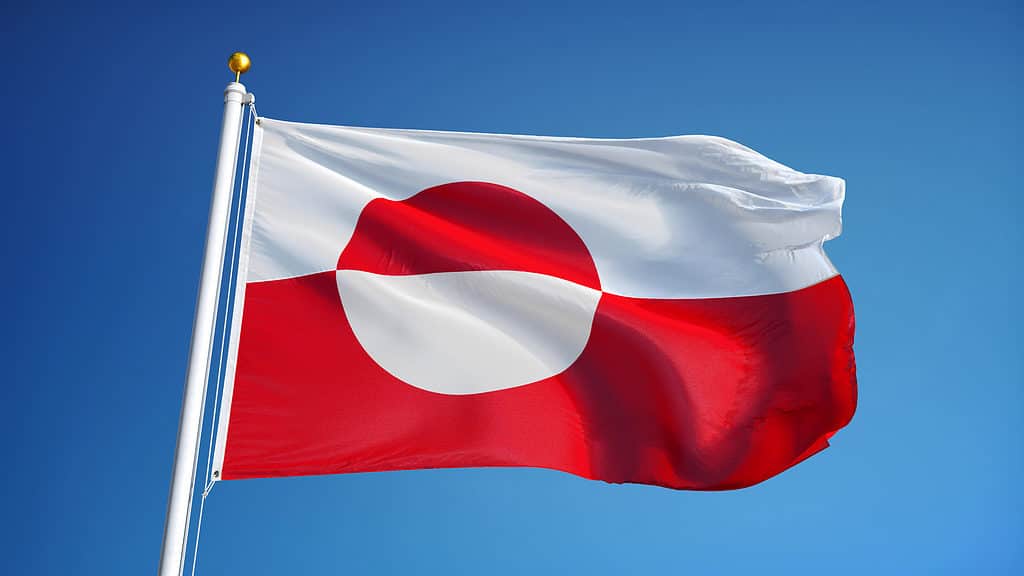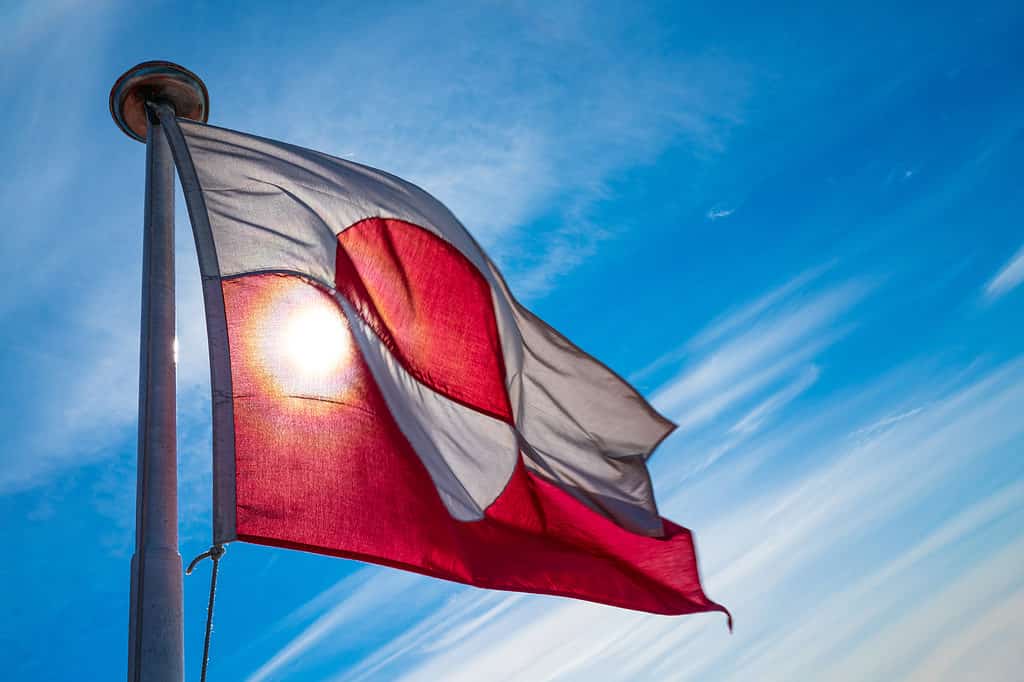Greenland is an island located in the country of Denmark (in Europe). Greenland is not just any island; it is the world’s largest island. It has its own national flag known as the “Kalaallit erfalasuat,” recognized in both Greenlandic and Danish. Locally, it is referred to as “our flag” in Greenlandic using Erfalasorput. The Erfalasorput and the Dannebrog (Denmark’s national flag) are regularly seen flying together among modern Greenlanders.
The Nordic cross flag, commonly referred to as the Scandinavian cross flag, is generally recognized as the emblem of the Nordic countries. The flag pattern, which includes Denmark, Sweden, Norway, Iceland, and Finland, is easily identifiable (a cross emblem with its center moved towards the hoist within a rectangle field.). The only Nordic nation that does not fly this flag is Greenland, which adopted its own design after gaining independence in 1985. Read on to learn more about the Greenland flag’s history, meaning, and symbolism!
Flag of Greenland History

The flag of Greenland is the only Nordic nation that does not have the Nordic cross in its design.
©railway fx/Shutterstock.com
1973
The first time Greenland thought about having its own flag was when five of its citizens submitted a design concept. It was a green, white, and blue design submitted in 1973. The following year, a newspaper made requests for eleven designs and polled readers to see which they liked best. However, this effort was not very successful then, so the Danish flag was preferred.
1978
Denmark granted Greenland parliamentary independence in 1978, allowing it to become a permanent member of the Danish Realm. However, Denmark maintained influence over a variety of areas, including defense, monetary policy, and Greenland’s judicial system.
A specific proposal for flag suggestions was made by the home rule government, and 555 designs were submitted (293 by Greenlanders). Other alternatives were asked because the selection committee could not come to an agreement. Ultimately, a red-and-white design created by politician, teacher, and Greenlander Thue Christiansen was chosen over a green-and-white Nordic cross by a vote of fourteen to eleven.
1985
After obtaining home rule, more than half of Greenland’s citizens elected to leave the EEC in a ballot held on February 23, 1982. This transition took place until 1985 when Greenland’s withdrawal from the European Communities after twelve years as a member gave rise to the Greenland Treaty.
The Greenland Treaty was ratified by the 10 nations that make up the European Communities on March 13, 1984. Then, on February 1, 1985, the Greenland Treaty came into effect. Soon after this, Greenland attained independence, on June 21, 1985. Christiansen’s flag design became officially recognized. The absence of a Nordic cross on the Greenland flag demonstrates the nation’s political independence and its close ties to other indigenous peoples from around the pole.
To commemorate the tenth anniversary of the Erfalasorput, the Greenland Post Office issued special postage stamps and a pamphlet created by Thue. He clarified that the large red part stands for the ocean, the white semicircle for the pack ice and icebergs, and the red stripe for the land. The ice cap and glaciers, which cover more than 80% of the island, are symbolized by the white stripe.
Flag of Greenland Meaning
The center of the Greenland flag is two equal horizontal stripes of white (on top) and red (on the bottom). It is slightly offset by a large disk with a red top and a white bottom.
Design
A sizable disk (red on top and white on the bottom) significantly offsets the center of the Greenland flag’s two horizontal stripes (white on top and red on the bottom). The flag is 18 by 12 parts overall, with stripes that are six parts wide each. The disk is eight parts in circumference. The hoist and circular centers are separated from one another by one part vertically and seven parts horizontally.
Colors:
Both the Danish and Greenland flags feature the colors red and white. Red and white are symbolic of Denmark’s long history as a member of the Danish Kingdom. The circle in the middle is also believed by many to represent the setting sun on the horizon and the warmth and sunlight emerging in the summer.
Flag of Greenland Symbolism

The flag of Greenland symbolizes the sun, the icebergs, and the ocean.
©Maridav/Shutterstock.com
Greenland’s ties to the Kingdom of Denmark are symbolized by the colors of the flag, which match those of the flag of Denmark. The ice cap covers more than 80% of the island, and the white of the Greenland flag symbolizes the glaciers. The red semicircle stands in for the sun, the white semicircle for icebergs, and the red stripe for the ocean. The design is reminiscent of the sun setting and its reflection on the water.
Up Next:
- The Flag of Algeria: History, Meaning, and Symbolism
- The Flag of Cuba: History, Meaning, and Symbolism
- The Flag of Serbia: History, Meaning, and Symbolism
The photo featured at the top of this post is © M_Videous/Shutterstock.com
Sources
- Britannica, Available here: https://www.britannica.com/place/Greenland
- Every Culture, Available here: https://www.everyculture.com/Ge-It/Greenland.html
- Best Flag, Available here: https://bestflag.com/products/nylon-greenland-international-flag
Thank you for reading! Have some feedback for us? Contact the AZ Animals editorial team.






